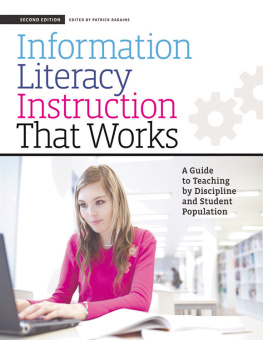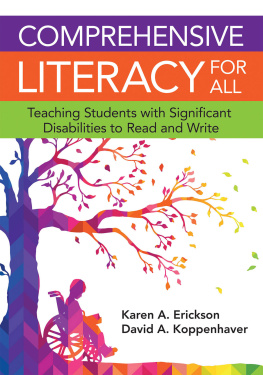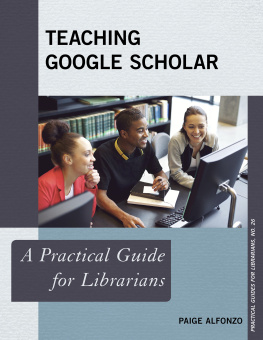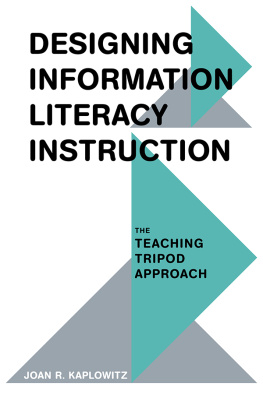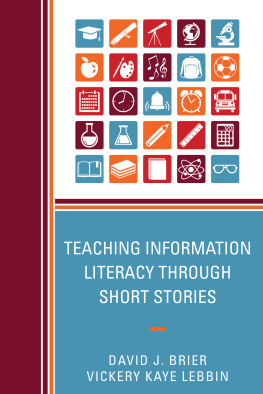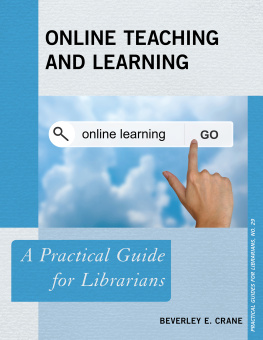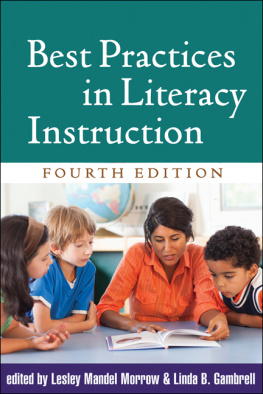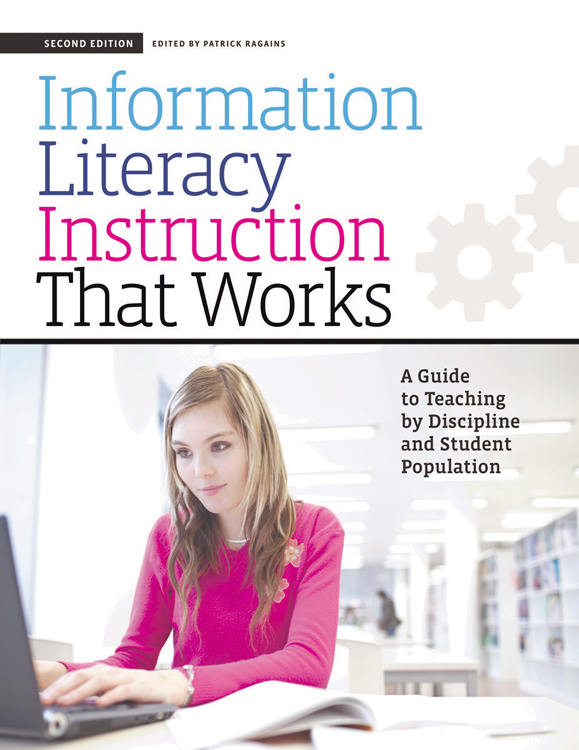
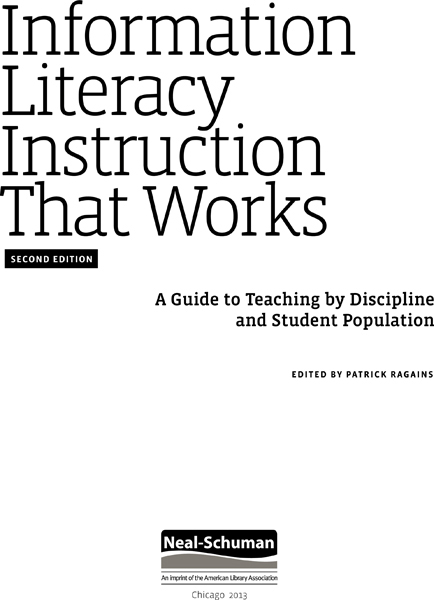
Patrick Ragains is Business and Government Information Librarian at the University of Nevada, Reno. He holds an MLS from the University of Arizona (1987) and an MA in History from Northern Arizona University (1984). He has published articles in American Libraries, Communications in Information Literacy, Journal of Government Information, portal: Libraries and the Academy, and Research Strategies, two of which were recognized by the American Library Associations Library Instruction Round Table (LIRT) as among the best 20 articles on library instruction published in 1995 and 2001. In 2008, his book Information Literacy Instruction That Works: A Guide to Teaching by Discipline and Student Population (Neal-Schuman, 2006) received the Ilene F. Rockman Instruction Publication of the Year Award from the Instruction Section of the Association of College and Research Libraries (ACRL) He is former chair of the ACRL Research Committee and is active in the ACRL Instruction Section.
2013 by the American Library Association. Any claim of copyright is subject to applicable limitations and exceptions, such as rights of fair use and library copying pursuant to Sections 107 and 108 of the U.S. Copyright Act. No copyright is claimed for content in the public domain, such as works of the U.S. government.
Extensive effort has gone into ensuring the reliability of the information in this book; however, the publisher makes no warranty, express or implied, with respect to the material contained herein.
ISBNs: 978-55570-860-3 (paper); 978-1-55570-874-0 (PDF); 978-1-55570-875-7 (ePub); 978-1-55570-876-4 (Kindle).
Library of Congress Cataloging-in-Publication Data
Information literacy instruction that works : a guide to teaching by discipline and student population / edited by Patrick Ragains. Second edition.
pages cm
Includes bibliographical references and .
ISBN 978-1-55570-860-3
1. Information literacyStudy and teaching (Higher) 2. Electronic information resource literacyStudy and teaching (Higher) 3. Academic librariesRelations with faculty and curriculum. I. Ragains, Patrick, editor of compilation.
ZA3075.I537 2013
028.7071'1dc23 2013010870
Cover design by Kimberly Thornton. Image lightpoet/Shutterstock, Inc.
This book is lovingly dedicated
to my wife, Bonnie Ragains,
and our son, Ben.
Contents
Patrick Ragains and Mark Emmons
Jean Caspers
Mark Emmons
Ann Roselle
Adina J. Mulliken and Bernadette A. Lear
Amy Elizabeth Hughes
Janelle M. Zauha
Peggy Keeran
Neal Baker
Laurie J. Sampsel
Patrick Ragains
Nonny Schlotzhauer
Catherine L. Cranston
Elizabeth Berman
Allison V. Level
Martin K. Wallace
Patrick Ragains
Patrick Ragains
Patrick Ragains
Suzanne L. Reinman
Tables
Figures
Exhibits
The following illustrations appear online as Web Extras accompanying this book and are available at http://www.alaeditions.org/webextras.
The need to find a broad range of information and the ability to analyze and use it effectively has never been greater, whether in education, in our professional lives, or in everyday settings. Students who copy others words and ideas without citing them can face sanctions for plagiarizing. Medical clinicians who overlook a relevant journal article can unwittingly cause the death of a patient. Inventors can waste time and money preparing a patent application that is rejected if they fail to discover prior related technologies and designs. Information literacy (IL) is at issue in each of these scenarios, and articulating and promoting it is a central mission of academic librarians. Information Literacy Instruction That Works: A Guide to Teaching by Discipline and Student Population, Second Edition, provides tools in support of that mission. Each contributing author details programmatic strategies and teaching techniques she or he has employed in tandem with other aspects of her or his work, including academic administration, serving particular student groups, building library collections, and developing websites.
This volume is an updated, expanded version of the original Information Literacy Instruction That Works (Neal-Schuman, 2006). Approximately 75 percent of the content is new to this edition. Much has changed in the intervening yearsour understanding of students and how they learn, library technology, and available resources. Additionally, three disciplines not discussed in the previous edition are covered here in depth (music, anthropology, and engineering). Throughout, librarians will find a wealth of information to use as they prepare to meet with college and university students at all levels, teach research skills in subjects that are new to them, or develop a campus-wide IL initiative. Students in masters-level library education can use this book to learn about and prepare for a wide range of instructional responsibilities in academic libraries.
Organization
Information Literacy Instruction That Works is divided into four parts, each addressing key questions:
What are the best ways to teach IL skills in colleges and universities?
How can librarians effectively teach an increasingly diverse student body, which has many students with specific needs?
What are the best ways to teach IL in different disciplines, each with its own ways of communicating and publishing?
How can librarians educate students to incorporate important resources into their research, including government and legal information, considering that these sources lie outside of the mainstream of information in many disciplines?
Each major part opens with an overview of the inclusive chapters. Each chapter illuminates a particular topic in depth, although all cover some common and essential issuesknowing your audience, determining what students need to learn, delivering instruction, and assessing the process.
The two chapters in , Jean Caspers discusses collaborating with faculty. She gives sound advice on building relationships for the benefit of students, presents and analyzes different kinds of facultylibrarian interactions, and provides sample assignments to use in shared teaching situations.
, Amy Elizabeth Hughes recommends best practices for teaching IL skills and furnishing library support to remote students.
Faculty often rely on librarians to provide information literacy instruction (ILI) in particular disciplines. Instructional librarians with such responsibilities usually teach basic information-gathering skills in addition to specialized strategies. Librarians typically find this aspect of their work quite stimulating. , Teaching Information Research in Specific Disciplines, details subject-specific instruction in the following 11 areas:
English Literature
Art and Art History
Film Studies
Music
History
Psychology
Anthropology
Science Literacy
Agricultural Sciences and Natural Resources
Engineering
Business
Five chapters from of the first edition of Information Literacy Instruction That Works are updated to reflect current research on information-seeking behavior, planning and delivery of ILI, and changes in information sources. New chapters on ILI in history and science literacy replace those in the first edition. Other new chapters cover ILI in music, engineering, and anthropology, each a discipline with different means of producing and using information. A single chapter on instruction for business students replaces two narrower chapters from the first edition on hospitality/gaming and international marketing.
Next page
